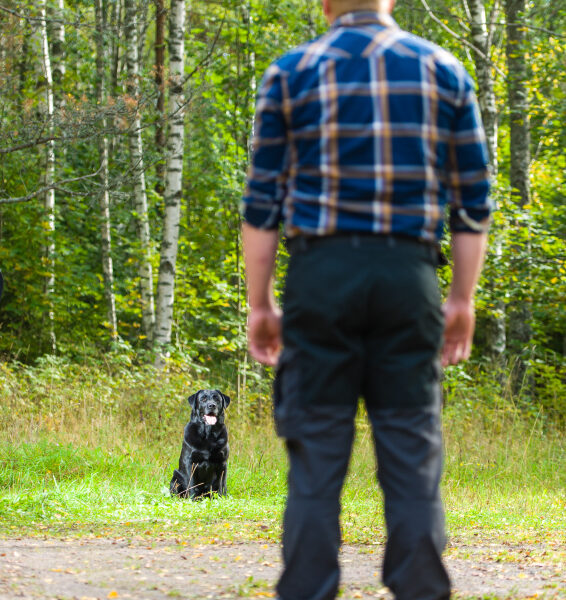BASED ON ORIGINAL MATERIAL BY PIPPA MATTINSON, UPDATED BY HEATHER JULIE CLAYTON FOR THE GUNDOG CLUB – OCTOBER 2022.
With casting back we need to think about all the different factors of difficulty that are involved.
The very first few times you cast your gundog back, he should be sitting in a specific position, in a specific location.
Ultimately of course, we will want the dog to cast back from any position, in any location, over any kind of obstacle, for blind as well as seen retrieves, and to do so under any amount of distraction.
But these are factors of difficulty and we need to build up to them gradually.
Keep it simple
Below are the Gundog Club’s first steps for establishing the basic back cast. This is not the only way to introduce the back cast, nor the only type of exercise you can use to practice back casts, but the steps below use a simple, clear progression that will help beginners to get this important concept firmly established in their dog’s mind.
The set up
Start by working in the same location, the same field or piece of ground, and with the dog in the same part of that field. Don’t try and do this until you know you have access to the same bit of ground for several days in a row.
Later on, when these basics are established you can rehearse these skills in lots of different locations and under increasingly challenging conditions. But for now, you need to be able to train in the same place, every day, for several days.
Train on a fairly even surface, short grass or bare ground is fine.
The dog needs to be sent back to something – a dummy, or a food bowl, or a placeboard or other target. It’s up to you what you use, and the best choice depends on your dog’s motivation to retrieve and whether or not you:
- have a complete retrieve chain;
- your dog is steady to thrown dummies; or
- have already built value in the behaviour of going to a placeboard or target.
In the steps below, we use the example of a dummy but if this isn’t suitable for your dog then you can easily modify the steps to use a food bowl or a target and work on any missing parts in your retrieving separately.
Step One
Our objective is to introduce the dog to the concept that the word ‘back’ (or whatever word you have chosen to use) is not just something he hears when he is at heel and ready to ‘line out’ to a dummy from your side. It does not just mean ‘fly out from the heel position at my side, directly away from me.
It is a cue for the dog that is working at a distance from the handler in the field and has been ‘stopped’ by whistle to await instructions. To this dog it means ‘turn around and travel directly away from my handler ’.
Teach the stop whistle separately, don’t try to teach it at the same time as you are teaching the back cast.
Hand signals
Before you start, you need to give some thought to the hand signals that you are going to use.
You could use a raised hand, like a policeman stopping traffic. But if you want to use this as a ‘stop’ cue, you’ll need to modify your own back signal and add some movement to it.
Finesse
When your dog sets off on a back cast, there are two different ways in which he can rotate. He can spin around to his right, or he can spin around to his left.
Some dogs have a great preference for rotating one way or the other. And if you wish, this is something you can control by teaching the dog to rotate in a different direction depending on which arm you signal with. This control can be useful in rotating a dog away from a diversion, but it takes a little extra time to teach, especially in dogs that have a strong preference for rotating in one direction. So many gundog trainers don’t bother with it.
If you like the idea of teaching a right or left ‘back’ cue, you can find instructions in the Gundog Club manual: Passing Grade Three.
The set up
Imagine you and your dog are standing in the middle of a large clock face. Your dog has his back to 12 o clock, and you have your back to 6 o clock. Sit your dog so that he is facing you, with no more than a few feet between you.
- Throw a dummy over your dog’s head to 12 o’clock
- Wait a few seconds then give your verbal ‘back’ cue together with your raised ‘back’ hand signal
If he remains seated just encourage him enthusiastically to get him after the dummy without repeating your cue.
- Take delivery of the dummy, reinforce your dogs as appropriate, and repeat
Progress
Within a very short space of time, your dog will be spinning around and fetching the dummy as soon as you give the cue.
Now you can introduce a bit of a time lag (up to 15 seconds or so ) between the throw of the dummy and the back cue.
Once the dog is reliably retrieving on your combined signal of a verbal ‘back’ and a visual hand signal, you can if you wish begin to drop the verbal ‘back’ (although many owners of Pet Gundogs re
Step two
Step Two adds a distraction dummy (or food bowl, or target) and this narrows the criteria for our new cue.
In this step we are starting to “isolate the cue” – that means we are trying to teach the dog to go back on our signal, and not just because the only dummy (or food bowl or target) is behind him.
So the dog learns this is not about fetching just any old dummy from his remote position, it is about travelling in a specific direction relative to you.
The right choice
He will understand this, because there are now two choices he could make, and we will contrive to make sure that he always makes the right choice. This is an important concept to establish, and it is surprising just how many dogs are confused by this at first.
Just because the dog spins around and collects the dummy behind him at Step One, does not mean he actually understands that the back signal defines the direction he must travel relative to his handler.
He is simply spinning around, because he knows that is where the dummy landed.
He needs your help now, to move on.
For this reason, we’ll make the new standard very, very simple to follow, and minimise any chance of failure. You’ll need two dummies in your hand for this exercise.
The exercise
- Sit your dog so that he is facing you, with no more than a few feet or two between you.
- Throw a dummy over your dog’s head to 12 o’clock
- Gently drop a dummy behind you (at 6 o clock)
- Give your ‘back’ hand signal
- If the dog tries to grab the dummy behind you (and plenty of dogs that are perfect at step one will try this) just repeat and make it easier – you can do this by making the dropping of the dummy behind you even more gentle, or even just pretend to put it down at first, then encourage the dog back for the dummy behind him and reinforce him mightily for success.
You now need to repeat this exercise until the dog ‘gets it’ and completely ignores the dummy you dropped behind you. Only when he is reliably going back on a hand signal alone, should you begin to develop the exercise
Develop the exercise
This is where you make the distraction, more distracting.
First you will throw the distraction to 7 o’clock. It is still very near to you, just that little more tempting. Practice until reliable. Do not lump this into a big step – you want the dog to be successful, so work in very small steps to ensure success.
Then move on to 8 o’clock, and when the dog is reliable here too, move on to 9 o’clock.
Take your time, especially if the dog is unsure. Some dogs will fly through this in half an hour, some will need a few sessions before they are spinning around for the ‘back’ dummy without hesitation. Work in small steps so the dog is successful, and you can reinforce him for the right choice.
Now you need to repeat the whole exercise with the distraction dummy thrown out to your right hand side (5, 4, and 3 o’clock) instead of your left.
TIP: If you have taught your dog left back and right back, rotate him away from the distraction.
Increase time intervals
Now you can increase the time intervals between the two dummy throws and after the last dummy throw (not both at once), so that the dog has to concentrate harder to remember that first thrown dummy.
Once your dog can ignore distractions to either side and still go ‘back’ on a single hand signal, you are ready to move on. Up to now the dog has been in the same place, and in the same location. Your next step is to start changing that – remember to work in small easy steps, so your dog is successful.
About the author

Heather Julie Clayton runs the Gundog Club, on behalf of the Gundog Trust and its Trustees.
She trains retrievers – the infamous Charlie, the beautiful Betsy, and the very, very talented Beanie – at Beanie Farm in Cornwall.


 Handling your gundog: casting
Handling your gundog: casting